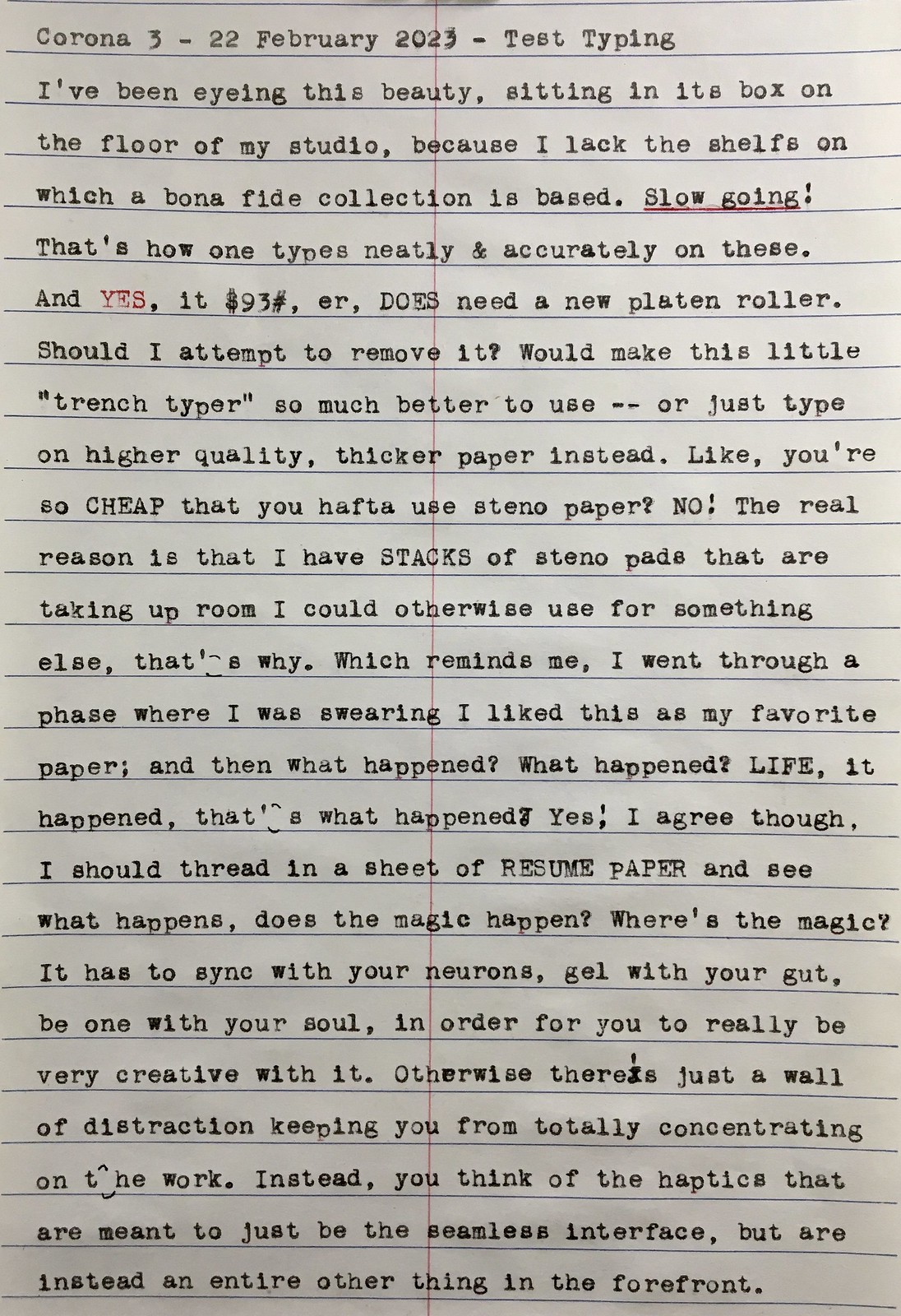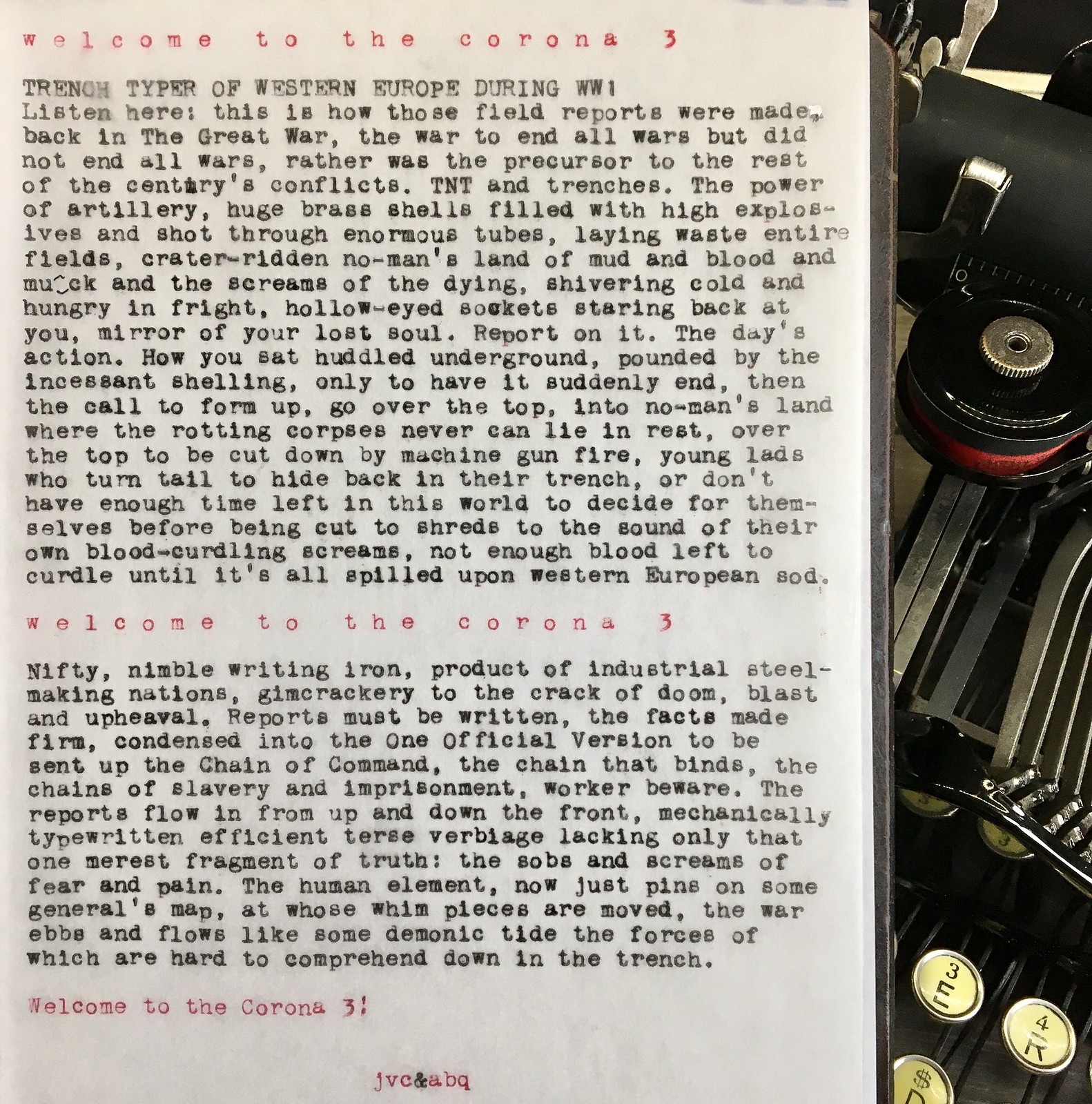Finding Sudden Inspiration in the Trenches

I've written and spoken a lot about creativity and inspiration, and how these can be fueled by our interaction with creativity-inducing devices like typewriters. I thought it would be fun for you to take a peek behind the curtain. What follows (after some more blah blah blah) is a random typing I did, after taking notice of the little Corona 3 typewriter, in its temporary plastic storage bin, sitting on the floor in the corner of my studio.
I have too many things in too small of a space, one aspect of being interested in collecting things like typewriters, but also books and other clutter-inducing objects. Hence the reason why the Corona 3 was on the floor in the corner instead of on a shelf. (Being stored in a temporary plastic bin is because its original carrying case is being restored.)
This last week, I've been having fun playing with some "type bar" electric typewriters, including the wonderful Hermes 10, our family typewriter when I was growing up in the early 1970s.

The term "type bar electric" may be cryptic to some: these are electric motor-powered typewriters that use the same metal "hammers" (i.e. type bars) to impact the paper with type as do manual typewriters, but without the strong hand and finger force needed with a manual machine. They're like a computer keyboard melded onto a manual typewriter.
Because they're so easy to use, that little Corona 3 was begging me to make a comparison of sorts: electric typewriter, representing the very end of the mechanical era before electronic machines, versus the Corona 3 that dates back prior to WW1. After a week of electrified typing, what would be my impressions of the more primitive Corona?
Here's what I hammered out on the Corona 3, just a mere test-typing to see how the machine performed, after weeks of disuse:

The last time I'd typed on the Corona 3, it gave me the impression that it wasn't as fun to use as when I first acquired it. But this typing session reminded me all over again that you have to use each machine at a pace that best suits the mechanics of the device. Speed demon it isn't. But you'll notice that phrase I typed: Slow going! This machine works best if you nestle your fingertips into the metal rings of the keycaps, feel the smooth surface beneath your skin, and distinctly type each character one finger at a time. Yes, you can touch-type it, but as you do so, experience each individual keystroke, the feedback force on each finger, the tactile experience, as you observe the letters become words become phrases become paragraphs. A work is slowly built up this way, one brick at a time, over a period of time, as you stay totally within the moment, experiencing each second of it. The staccato sound of type bar impacting platen, one finger at a time, is merely the ticking of the clock that marks time well-spent.
In the middle of this piece I became distracted with recounting my recent infatuation with typing on stenography paper, wondering why I quit doing so and lamenting the stacks of steno pads I'd acquired. Then, near the bottom of the page, I begin to talk about the wall of distraction keeping you from experiencing the magic of mechanical writing, and how you have to first gel with the haptics of the device.
This gets us back to the top. Gelling with the device means understanding its limitations. Not all typewriters were designed to operate at blazingly fast speeds with effortlessness. And though my Selectric or Hermes 10 or Royal KMM, or many other machines in my collection, could enable me to write much faster than with the Corona 3, there's no arguing that, in this instance, something creative actually went down. Here's what I typed on the Corona 3 shortly after finishing the above page. I threaded in a thin sheet of tracing paper, almost as thin as onionskin, and here's what came off my fingertips and onto the paper fibers as impressed ink markings:

I'm certain it was the phrase "trench typer" in the first piece that inspired this second one. Also, I'd been looking at photographs of typed action reports made during WW1 using the Corona 3. Here's one such example:

My point in all this is, if ergonomics and haptics are any indication, in theory the "better" typewriter should enable heightened creativity, like some 1:1 linear, logical correspondence between efficiency of operation and quality of output. Yet, this small page of text was perhaps the best thing I've written all week, a week that's seen me typing on a variety of machines much more efficient. Somehow this slow, plodding trench typer seemed to have moved me sufficiently to put those words together in a manner emotionally significant to me.
Don't assume every typewriter can or should be used blazingly fast, because often you'll find yourself with skipped spaces or piled on letters, or other issues, as you out-do the machine's intended pace. It's like riding a horse (which I know nothing about, BTW) -- you have to learn to cooperate with the animal, ride at its pace, and you'll get to your destination faster than stopping every hundred yards to beat some sense into it.
Sometimes the speed of thought is the real limitation to creativity, rather than the words per minute thrown down. It's not the quantity of work, but the quality. This is especially difficult to accept if you're struggling to write professionally. We think we need to be like Andy Warhol's Factory, a mechanized assembly line of creativity. I believe creativity, rather than assembled from a kit using neatly written instructions, is more like a garden, it needs to be tended to, cultivated, fertilized, for there to be growth. And what does grow doesn't do so to the schedule of the quarterly earnings report.
Take your time with those "trench typers," relics of an earlier age. Get in the spirit of a slow, meditative pace of thought. Synchronize you breathing with your fingers' pace upon the keys. Experience each keystroke as individual moments in time. Let the experience speak to you, then write down what you hear.

11 Comments:
Heh, I really like it when you go all free-associative with an inspiring machine. (:
Joe, I really appreciated your recent comments on my own blog regarding how I might go about creating new content. Even better is seeing you continue to lead by example.
Joe, really felt Hemingway spilling through.
I read your second text on OTP before reading this post. It all came together here.
How timely. Earlier, I was struggling with my dad's typewriter skipping until I typed in a more even rythm, effectively not so much slower but more equal.
I truly appreciate how this article highlights the unpredictable nature of inspiration. I've had similar experiences during my nursing studies, and take my online nursing exam has been a lifesaver in those tough moments. It's allowed me to keep going even when the life gets tough
I truly like how this post highlights the unpredictable inspiration can be. Similar situations have happened to me when studying math, and the online math masters assignment has come in very helpful at times. It has enabled me to persevere through difficult times in life.
Sudden inspiration always seems to strike when we’re deep in the trenches of work or stress! It’s amazing how creativity can spark in the most unexpected moments. I’ve been so busy lately that I’ve even considered finding someone to pay someone to do my statistics exam just to lighten the load and free up some mental space for more inspiring ideas like this
In challenging environments, especially when working on large-scale construction projects or managing fleets of vehicles, inspiration can strike when you least expect it. Whether it’s finding a new way to streamline operations or discovering more efficient solutions, those moments of clarity often emerge when you’re deep in the trenches of day-to-day work. For those in the automotive or construction industries, Fleetsworld offers the latest innovations and tools to help turn those ideas into actionable strategies. Staying informed about cutting-edge technology can make all the difference when creativity hits
Finding inspiration in the middle of chaos is such a powerful experience! It's amazing how creativity can strike when you least expect it. With everything I've got going on, especially exams, I sometimes feel like I should pay someone to take my online exam just to clear my head and focus on those unexpected bursts of inspiration
This piece brilliantly captures the spark of creativity that emerges even in the most challenging moments. I love how it shows that inspiration doesn’t wait for comfort—it strikes in the trenches, turning struggle into insight. By the way, Eco Liv is also making life easier by providing the best deals and discount codes on electronics, pets, jewellery, travel, gifts, clothing & apparel, and much more. Truly refreshing and practical!
Funny how inspiration shows up when you're deep in the trenches and least expecting it. Even while scrolling through Trusted brands providing fashion, clothes, shopping, shoes, makeup, skin, beauty etc., a random spark can hit out of nowhere. It’s wild how the mind finds clarity in the most unexpected moments.
Post a Comment
<< Home